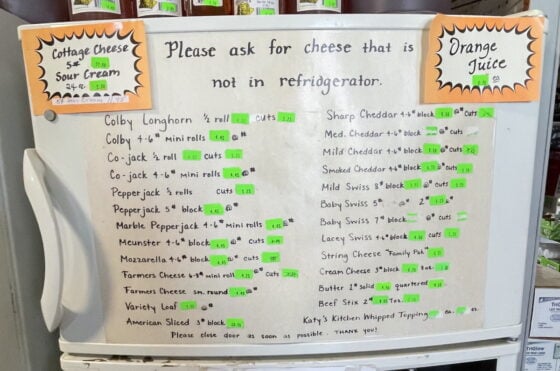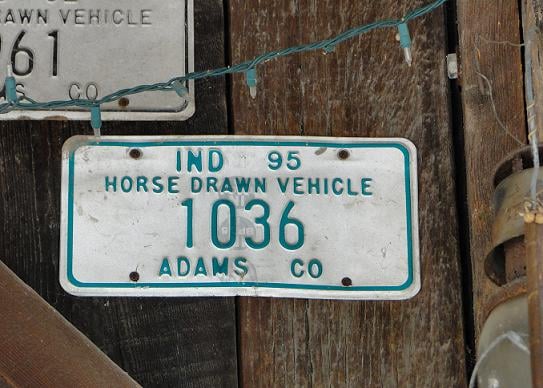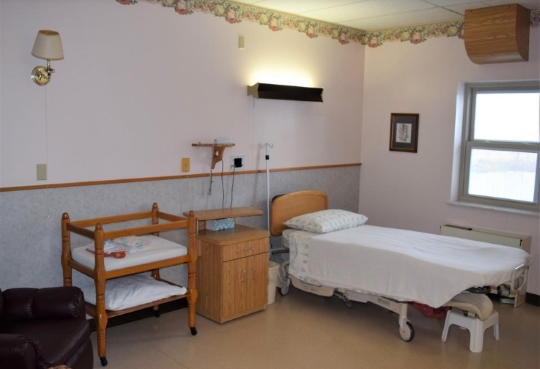The Amish Mother’s (Increasingly Important) Role
I’m in Lancaster County this week, catching up on all the pie I’ve missed eating, and doing other important thing like that…but I will be popping in here periodically. And we have some posts lined up for you.
Look for another “Five Points” list post on Wednesday (topic hint: this week’s list was inspired by the response to one of last week’s posts).
And on Thursday we’ll be hearing from Karen Johnson-Weiner, about a special type of home found in Swartzentruber Amish communities.
But first, Jim Cates returns today with part 2 of his look at Amish women and gender roles. Part 1 is here if you missed it.
—
It’s No Use Going Back to Yesterday
In her confusion, Alice says to the Mock Turtle, “But it’s no use going back to yesterday, for I was a different person then” (Alice in Wonderland by Lewis Carroll, 1865). Despite the effort to hold the Amish at a nostalgic arm’s length and perceive them as a cultural backwater, we are faced with the truth. They too are different than yesterday. Even the manner in which they hold traditional values, such as gender roles, has changed subtly across time, although certain factors remain stable.
For example, American families, both Amish and English, are shrinking. The average U.S. household has less than three people, the diminishing numbers in part due to aging baby boomers. While Amish families may also be shrinking, they continue to average five to six children per family, as opposed to an overall American average of two children per household.
That difference is a significant consideration in the pattern of parental employment. A large family requires a caretaking parent in the home in a way that a smaller family does not. The Amish mother’s role is crucial for a more extended period of time than is true in smaller English families. Amish mothers more frequently care for newborns and infants, and are caring for children for a longer duration as they mature from oldest to youngest.

Consider also the emphasis on agriculture and animal husbandry. Even as available land dwindles, Amish families maintain farmettes, or smaller plots of land on which they can garden and provide pasture for the horses necessary for buggies and farm equipment. The demands of caring for these animals and tending crops is assisted by the children as they grow older, but a parent is still needed to provide overall supervision. Again, the role of a mother is crucial in the home in a way that is unnecessary for city-dwelling or suburban families.
Ironically, the Amish family still faces a fragmentation that was not true in the past. As fathers and older brothers work in factories or construction, they remove themselves for long periods of the day from the family environment. In the past, when farming was still a viable option to sustain an income rather than supplement it, males were a more pervasive presence in the home. Mothers now loom larger as the parental figure there, as roles are parsed and the traditional effort to work the “family farm” diminishes.
Homemaking in Community
The parallels with the experience of the larger culture in the United States are clear. While there has been no crisis such as World War II to catapult women into men’s roles, they assume greater responsibility for parenting and the home, a component to the restlessness and dissatisfaction that spurred feminism in the latter half of the 20th century.
The concern some feminists express for a woman in this role is the lack of acknowledgement for the work she performs. There is no financial remuneration. Instead, she is dependent on the income generated by her husband, although in some cases she supplements these funds with a side business. And there is always the risk that others will lack appreciation for her work.

The distinction that can be overlooked is the role of a homemaker in a collective versus an individual culture. Situation comedies often use the foibles of family life as fodder for plots. Frequently, the story line focuses on the difficulties when two or more families attempt to coordinate an activity or run headlong into trouble as they manipulate around each other. These comedies highlight the independence in our lives.
By contrast, the Amish as a collective society rely heavily on family and neighbors. Homemakers are less isolated, intertwined with their siblings, adult children, and friends in all that they do. This involvement gives a camaraderie and cohesion to tasks that is lacking when these same efforts are pursued independently.
Measuring Success
We in mainstream culture also bump our heads on the awareness that women are trapped by the “glass ceiling,” and that they continue to be unequally paid for completing the same work as men. We measure equality in dollars and cents. Coin of the realm is a simple and concrete way to analyze the success of our egalitarian efforts. However, in a culture that encourages humility over the ostentatious display of wealth, it fails to faithfully capture the elements of equality in gender roles.
The Amish do not view work as we do. They may see themselves as craftsmen, as artisans, or as highly skilled in the performance of their jobs. However, they do not aspire to “success” in a worldly sense of reputation and fame as an individual. (I think of one man who built carriages that were used, among other places, in a presidential inauguration and a Miss America pageant. I learned of his skill by sheer accident.)

Their accomplishment speaks to their ability as a gift from God. As such, if they are able to make money, that may be a source of material comfort, but it is not expected to be a source of pride. In this context then, the woman whose role is that of wife and mother, but who receives no financial remuneration for her work, is not diminished because her efforts are unpaid. Rather, she is serving in a role of importance, just as her husband does.
The nature and purpose of gender roles is much more complex than it appears at first glance. Although similar to our experience, in that they are intertwined with economic as well as cultural expectations, all too often we view Amish roles through our own perceptions. Instead we must consider the context in which theirs occur. However, the fact that gender expectations are culturally based does not mean that all aspects meet with equal emotional acceptance. The submission of women is based on Biblical principles as the Amish see them, and is the subject of the next post.
Jim Cates is author of Serving the Amish: A Cultural Guide for Professionals. He can be contacted through this blog or his website at servingtheamish.net.
All images by ShipshewanaIndiana









A woman is the helper of her husband and so long as she is a good helper, she has served her role well. The man provides the family with what it needs and the mother takes what is provided and prepares it into that which is needed. If a man gives a woman straw, a good one will have a hat and handbag by the end of the day.
These are all things I learned.
It is a desperately shallow mentality (whether by an individual or a society) that measures the value of one’s labor by the size of his paycheck.– DBurke, 2015 😉
I grew up in a family of five with a stay-at-home mom (at least ’til all the kids were in school), and a pastor-mechanic bi-vocational dad. My adult life has been in a two-income family of public school teaching and full-time minister — both arenas notorious for less than professional grade pay. So I know this side of the story…, and my response is, “so what?” Our value — and the value of our contribution — is not in any way tied to income. Our value is rather measured by the degree to which we strive to do a good job with what we have; it is measured by the potential impact that we have in the macro- and microcosm of the world around us. Money can buy things, but it can never buy happiness — and in fact, it often brings more problems than it solves.
Contentment — not income — is the real prized, and that is a prize that is greater than hundreds of thousands of dollars. And the threshold for contentment is nothing more than having food to eat and clothes on our back.
Our contribution to the greater cause earns us the same value as the more visible ones in that same cause — and whether here or the hereafter, we will be duly rewarded (but not necessarily in monetary gain).
So those that focus on income instead of impact — they have a shallow perspective indeed. And who among us could ever dream of having a greater impact than the hand that rocks the cradle?
Thank you for this reminder. I needed this today. It’s as if God’s words came out of your mouth directly to my heart.
Dody, glad to be of any help that it might have offered. And truth is, most of what I said was just adaptation of what the scriptures say — so, yeah, there is probably good reason that some of it might have sounded like God’s words. 😉
Excellent saying, Don! Can I quote you? If I had the time (if could retire now rather than work full time for another 3 years 6 months, 9 days…until full Soc. Security), I’d stitch it into a sampler!
Unfortunately, contentment can depend on being equally yoked, which is often not the case. 😉
Alice Mary
Alice, you flatter me. If I knew I was scripting for all posterity to share, I would have put a little more spit and polish on my wording. But yes, you are more than welcome to quote me.
I’m not so sure what you mean by depending on being equally yoked (which I take to being a ref. to marriage). But I do know this: Many is the good woman that is the real basis for her husband’s success. While every man is responsible for what he makes of himself within his situation, a gal can go a long, long way in either making or breaking that situation. And a wife that provides the stable and nurturing environment that allows her husband to make an impact in his world, *she* is responsible for the outcome as well as he is. And even if the world has no reason to know her contribution, and even if she sees little or not financial compensation for her efforts, there is One who knows and will dibby up the fair and just rewards in due time — either here or in the hereafter.
The Amish Mothers increasingly important role
I have a problem with articles like the one Jim Cates made over Amish Mothers role, and his experience withProfessionals interactimg with the Amish. It is generalizations like this about the Amish that confuse many in our English society the very ones that read these posts. Amish do not have the capability of reading them so we will never get a constructive rebuttal from them. When we speak of the Amish or Mennonites on specific issues unless we know what Church Group they belong to, for instance ” Old Order Amish” and the State and County and even city they live in, then we have no idea if those Amish or Mennonites around where WE live act in this manner. Amish or Mennonite Church Groups even a few miles apart may have different Ordnungs which govern how they carry on their lives. Even when we speak of the Amish Swartzentrubers there are 3 or more kinds of Church Groups all with different Ordnungs and way of living. In my long experience with the Amish Swartzentrubers in Heulvelton, Norfolk, in St Lawrence County, starting in 1974, those in Oneida County, NY they are different. The olld Order Amish around me in Vernon Center,NY appear so far to be very much like they were decades or more ago. There is a clear cut role for wives and husbands, the husbands take care of the farm animals, plowing etc and the women the home, the gardens, and road side stands. Amd one more thing. In Tje world today we have over 20,000 different Christian religious groups. All of them have different ways of interpreting the bible, and living their lives. Their bibles etc have been changed many times since the Protestant Reformation. The Amish and Menninites as far as I know use rhe same one passed down by their ancestors since they left Switzerland, Austria, and France. Their Church Hymnal has been passed down also in its original form. That is why most Amish speak English, pennsylvannia Deutsch ( similar to German Platt Deutsch) and High German. Our Children speak English which seems to change every day and reading a book published 100 years in our Country is almost unreadable because of the change in our language.
Observation
The greatest threat the Amish face comes from the values they adopt from the English. I speak plainly about groups like evangelicals who pester the Amish in Lancaster, hoping that they abandon their ways and see Jesus the way they see Jesus.
I hope the Amish won’t be effected too much by working in factories or owning small businesses. The Amish have been in those ventures since the 1970s. The woman’s role doesn’t really change that much. They still have to look after the kids and many of those kids will still be going off to Amish schools which are typically longer than public schools. When their children are done school around the 8th grade, many of them will help mom with the garden and household, or they will help father in the small business. Those that don’t have a small business or farm still help mom around the house or work at farmers markets and side of the road stands selling produce, quilts, ice cream, doughnuts, candy, handcrafts, furniture, etc. Maybe not a lot of money is made from these ventures, but they still help keep Amish children working and busy instead of getting into trouble.
There are a lot of side jobs that keep children busy and which help take the workload off of mother. For the mom, having extra children, especially over a certain age means less work for her. She could use the extra help to cook the meals, watch the little ones, or help with any side job.